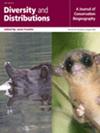Range Shift and Climatic Refugia for Alpine Lichens Under Climate Change
Abstract
Aim
The mountain biodiversity is highly threatened by climate change, with many species facing habitat reduction and/or local extinction. Poikilohydric organisms like lichens are extremely sensitive to environmental conditions and changes. A comprehensive overview of the impact of climate change on the future distribution of lichens is still missing. Thus, we quantified the range shift, loss in suitable areas and potential climatic refugia for more than 250 lichens, exploring these trends for each species and grouping them by their ecological needs and functional traits.
Location
Alps chain and surrounding areas (Europe).
Methods
We performed species distribution models to investigate the range shifts of 272 lichens under different climate change scenarios. Range shift was investigated by modelling gain and loss in suitability score along the elevational gradient, for each species separately and grouping them based on growth forms and temperature-affinities. Based on the ‘high suitability score stability’ index we developed maps of potential refuge areas.
Results
We predicted a huge loss of habitat suitability over time, especially under the SSP5-5.8. Fruticose lichens and cryophilous species will be the most impacted. Moreover, contrary to the assumption of an upward range shift, most species showed no significant relationship between altitude and increase in habitat suitability, suggesting different redistribution patterns for lichens. In the same way, climatic refugia are not only identified at high elevations but also in deep valleys and cold exposure.
Main Conclusions
The response of lichens to climate change is extremely heterogeneous, and an upper-range shift is less common than expected. Spatial redistribution is highly distinct among functional groups. The identified climatic refugia confirm this pattern, underlining the urgent need to improve the conservation effort, especially for fruticose and cryophilic species.


 求助内容:
求助内容: 应助结果提醒方式:
应助结果提醒方式:


